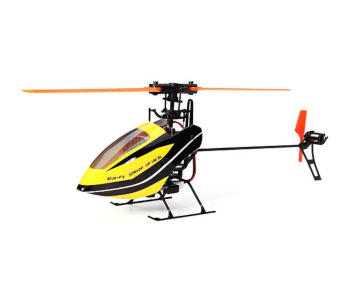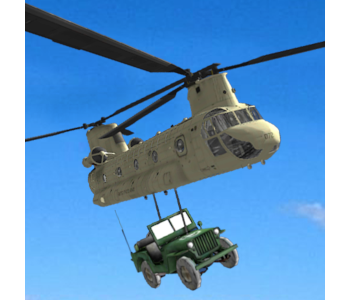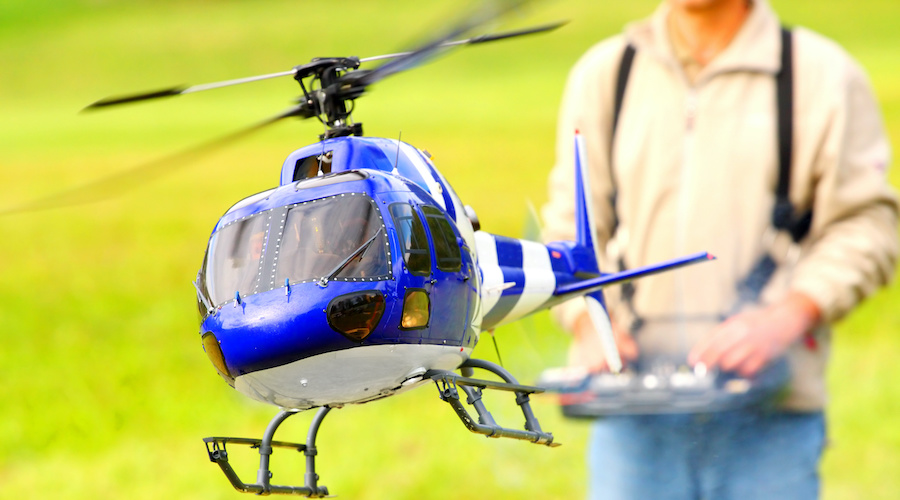Best Large RC Helicopters
Large RC helicopters are real head turners. Some of them are so big they’re close to the real thing. It’s a pursuit that RC pilots grow into, not start with. Replica helis are amazing at any size, but it’s when they get to scale that they genuinely come to life. These incredible models can get expensive, and the hobby is time-consuming. That’s why most enthusiasts like to try before they buy.
It’s possible to find clubs that offer trial flights for those ready to dip a toe into the proverbial water. There are friendly R/C heli clubs all over the US. Many of them should hold events for interested parties. Some clubs may let you take full control of a 1/4 scale whirlybird—under expert guidance.
Types of Large Scale Helicopters
Fans with time on their hands like to build scale models. It lets them focus on intricate details when they model the chopper on an original version. The great thing about scale helis is that you can get up close and personal. It’s incredibly relaxing working on these birds. Having access to the interior also makes the experience more enjoyable. Scale helis are a niche interest, but it’s gaining in popularity.
Pod & Boom Vs. Scale

Pod and boom helicopters are just that—a pod and boom. The pod is the upfront section that houses most of the mechanical systems. The extended carbon fiber or aluminum tube that exits the back of the pod is the boom. And attached to the end of the boom is the heli’s tail rotor. These are the most common sites in the sky. They’re also the best choice for anyone just starting with scale models.
Large model helis are also pod & boom, but with a scale fuselage. It’s these covers—also called skins—that turn the birds into impressive replicas. There are no limits as to what hobbyists can replicate.
Why Pod & Boom for Newbies?
It’s not wise to start flying scale helicopters without experience piloting smaller RC aircraft. There’s no law to say you can’t, though. Still, it makes sense to get experience first and progress through the ranks as it were. Some clubs won’t allow the raw novice to fly either. So, if you’re new to large choppers—but not new to flying RC—consider pod and boom over scale models to start with.
The two reasons pod and boom are better for new enthusiasts are:
- Simplicity
- Cost
The start-to-end costs of large-scale helicopters can be considerable. They also need certain skills and time to complete. Let’s look at why pod and boom helis make more sense for first-timers.
#1 The Simplicity Aspect
The heli is a lot simpler to work on and maintain when there’s no scale fuselage in the way. Pilots usually make lots of adjustments to a new model, both dynamic and static. The pod and boom style lets you see and access all areas of the bird quickly and easily. It’s no fun taking the scale fuselage on and off. Indeed, many skilled pilots would leave the skin off a new heli for a while anyway.
#2 The Cost Aspect
Every RC pilot experiences crashes and hard landings. Sometimes it’s pilot error and other times a fault with the model. The point is that crash damage is an unwelcome yet unavoidable part of the hobby. Anyone who invests in a scale helicopter needs to understand that costs can be high and ongoing. You can hope to be lucky but must prepare for what could happen.
As you improve the aesthetic features of your giant, the more fragile it becomes. Also, added details increase both the cost and weight of the model. A high-quality fuselage made from fiberglass is light but expensive. The price can be the same or even more than a competed pod and boom heli.
How Big Is Big?
Some scale helicopters are huge and getting larger all the time. The biggest at the time of writing is the EC-135 ADAC Notarzt Christoph 33. And no, you won’t find birds like this on Amazon. It’s a truly incredible sight. Everyone who comes across it on the ground or in the air is compelled to stop and look. It’s a scale model replica of a German rescue helicopter, and the details are remarkable.
Scale Heli Kits
The choice and quality of scale conversion helicopter kits gets better every year. Prices typically start from a couple of hundred dollars and up. You need to buy the power and radio systems separately with most of these. Pilots prefer this as they get to choose parts and components that best suit their needs. Always make sure the model has readily available spare parts and upgrades.
Scale helicopter features and buying considerations can include the following:
- Minimum age level
- Skill level, i.e., advanced, or expert
- Estimated build time
- Detailed surface areas w/ molded, highlighted panel lines and rivets
- Pre-painted scale fuselage (optional)
- Fuselage material type (see below)
- Includes scale parts
- Rotor type
- Power system requirements
- Radio system requirements
- Flying weight
Experience matters

Experience is so vital for operating large scale helicopters. Safe flying is always the priority of course. More experience also means less unnecessary damage caused by pilot error. The shells or skins look fantastic, but they don’t cope too well with heavy impact. There’s nothing more soul destroying than watching a scale helicopter hit the ground and disintegrate.
Pilots experienced on small R/C whirlybirds can also benefit from training as they make the transition. Flight simulators and guidance from qualified scale model pilots can be invaluable. A reputable training school is sure to use buddy boxes as part of their flight training programs.
The benefits of a buddy box
A buddy box is a teaching tool. The student’s transmitter or TX connects to the trainer’s TX via a cable. The experienced large scale heli pilot can quickly switch control between the two. That’s typically done with the simple press of a button. So, the trainer can take back full control of the bird in a nanosecond if the trainee gets into difficulty.
You don’t have to build or even own a scale helicopter to experience one. That’s why training programs are so invaluable. They offer an affordable introduction to giant choppers. Most folks know after a few sessions whether they want to pursue scale models or not.
What You Need to Know
RC scale heli kit builders are typically at the advanced or expert levels. Less experienced modelers can buddy up with experts and draw from their knowledge. You can find scale helicopters in almost ready to fly (ARF) and full kit formats. Pilots usually need to source and install the electronics in electric models. The builder must also install the mechanics with kit versions.
Fuselage Materials
The fuselage of a large-scale RC helicopter is available in the following two materials:
- Fiberglass
- Carbon Fiber
#1 Fiberglass
Most large-scale RC helis have fiberglass fuselages and canopies. It’s a heavier and stronger material than the polycarbonate found on smaller models. That makes it more expensive too, but it’s a necessary cost. Fiberglass also provides the ideal strength/weight ratio, and it has long-lasting properties. It also handles vibrations well and lower temperatures.
Another standout feature of fiberglass is that it’s easy to fix light damage. Fiberglass fillers are readily available and straightforward to work with.
#2 Carbon Fiber
Carbon Fiber is the preferred choice but not the standard. That’s because of its high price tag. It’s better than fiberglass as it’s considerably lighter and stronger. The expense, though, means most scale helis only use this material in high-stress areas. You can find carbon fiber fuselages and pod covers, but you have to dig deep into the pocket to acquire them.
Scale Heli Kit Requirements (not included)
No two electric scale models are the same. Even so, kit versions typically need the items below to complete and must be included in the total cost:
- Helicopter mechanics
- Rotor head and blades
- Cockpit
- Flight controller
- Electronic speed control (ESC)
- Brushless motor
- Three cyclic servos
- Tail servo
- Flight battery
- 6/7 channel radio
- 6/7 Channel receiver
The kit makers usually list the recommended parts, but pilots are free to choose. There are also spare parts and upgrades to consider. Remember that building and flying these big birds is a labor of love, and pilots relish the tinkering and tweaking. Another thing to consider is the instructions. Not all kit makers provide guidance or it may be vague. Poorly translated guides are another problem.
Do Your Homework
Familiarize yourself with the model you’re interested in before you buy it. Understand what scale it is, which relates to the original bird it replicates. You want to know what the kit includes and what you need to buy extra. The build time and instructions are other purchase considerations. There are sure to be video tutorials uploaded to sites like YouTube if it’s a popular model.
The purchase price of the body kit is only the start. Tally up the amount for all other parts and systems so that you know what the final cost is likely to be.
Summing Up
It’s with you for life if the bug bites. The building, tweaking, and flying of large scale helicopters is a fascinating hobby for RC enthusiasts. The community is friendly and highly supportive of one another. You get to make new friends and partake in events up and down the country. It’s always changing as large scale helicopters, capabilities, and new technologies continue to evolve.

